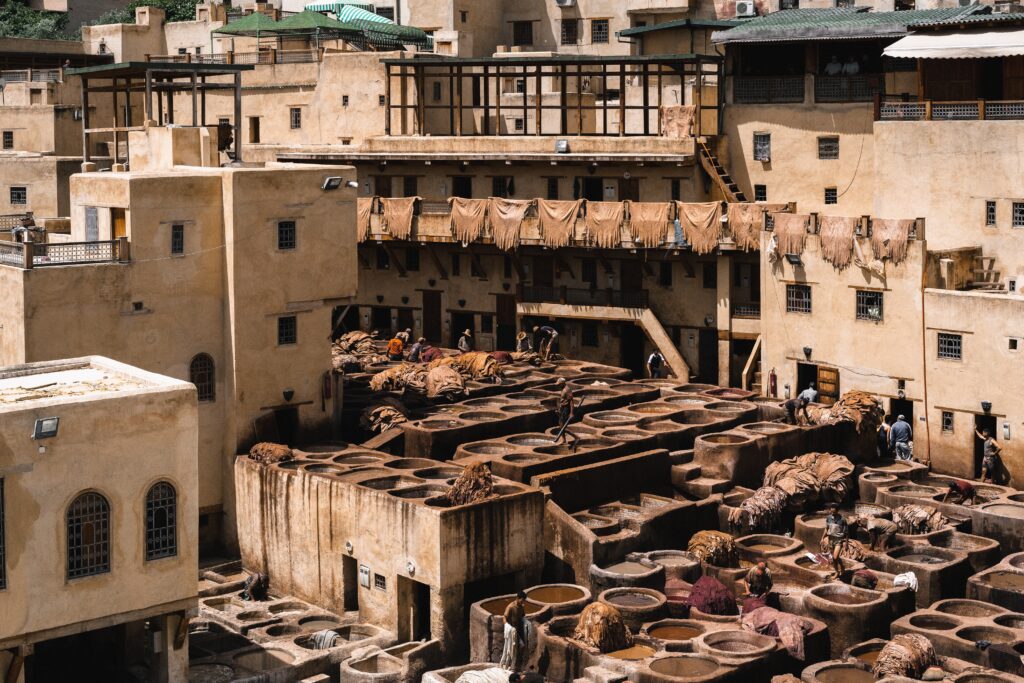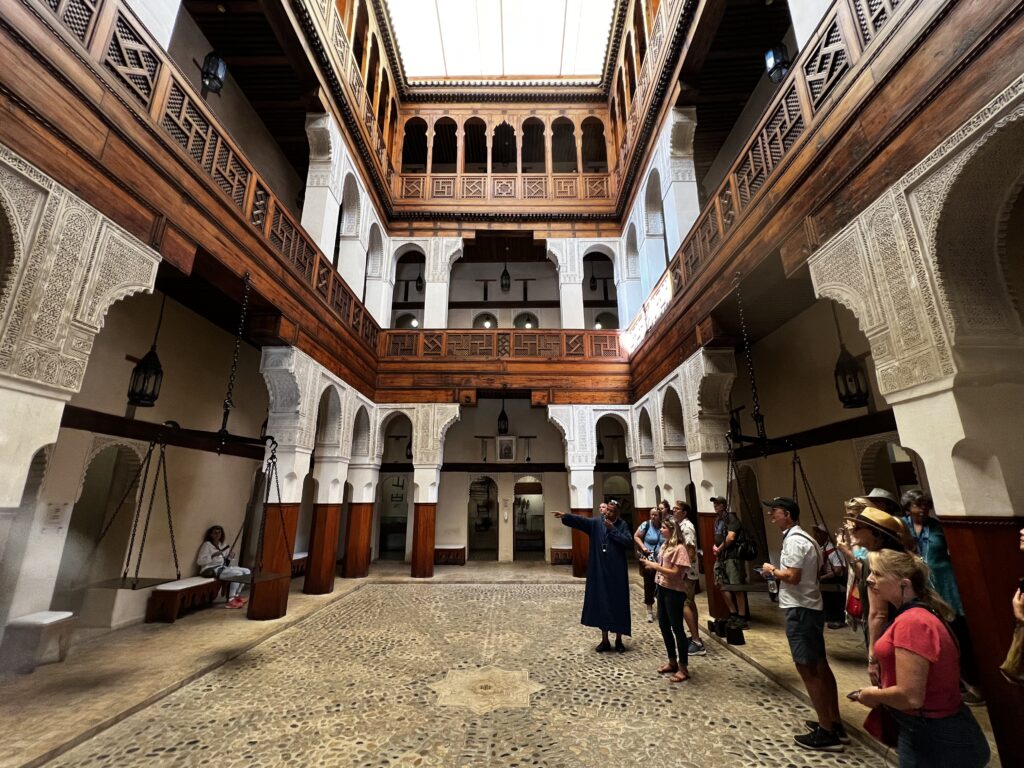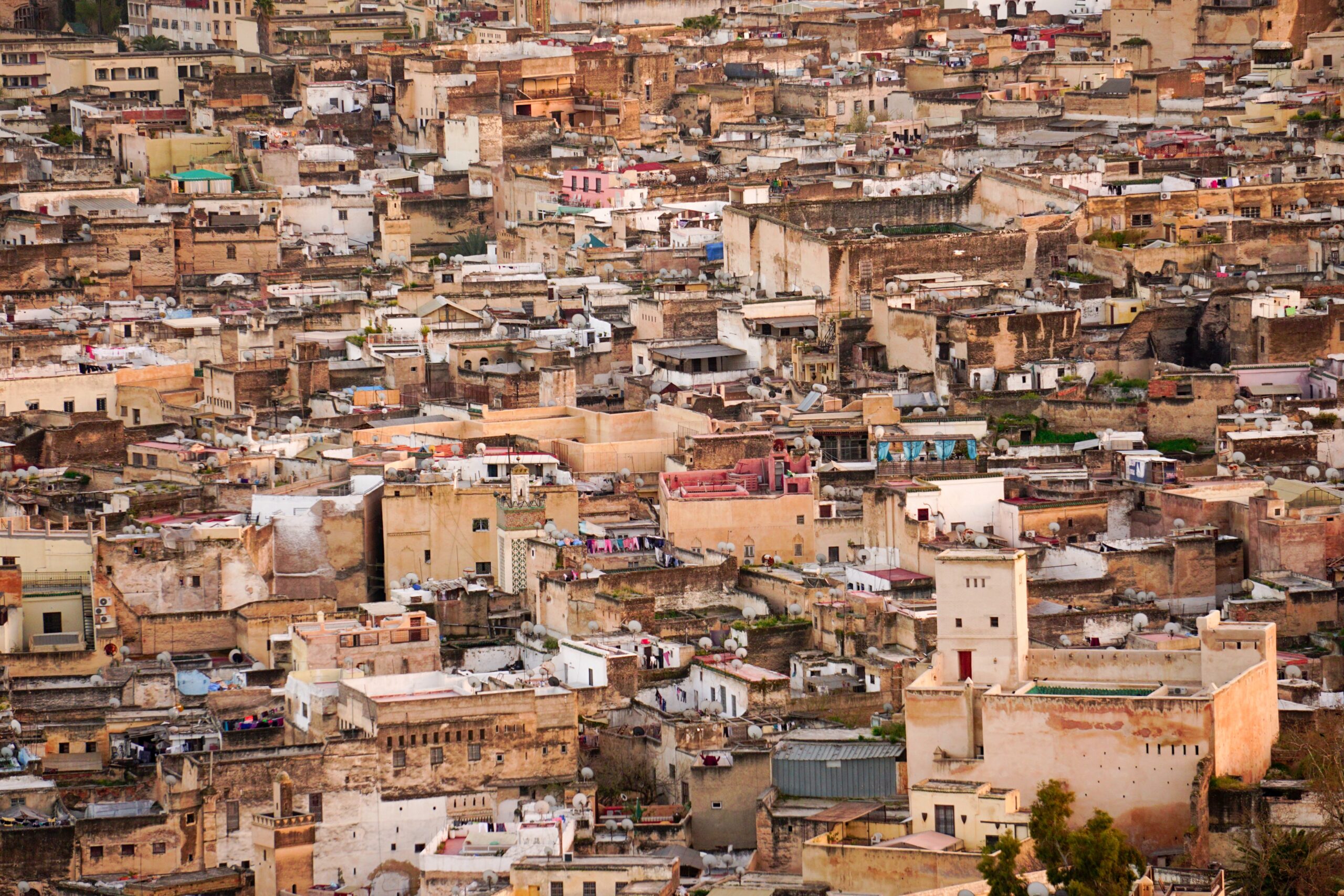Fes, Morocco’s imperial city, is located between the rich lands of the Sas and the forests of the Middle Atlas. It is the epitome of the country’s history as well as its spiritual and religious capital, and it has been designated a UNESCO World Heritage Site. Fès el-Bali, Morocco’s third-largest city, comprises of the historic center; Fès el-Jedid, the imperial capital of the Merinids; and further south, the contemporary neighborhoods established under the Protectorate.
1- About Fes
Fes looks as a compact and finely woven urban fabric as viewed from the peak of the hill of the Merinid tombs. Fès el-Bali, the medieval medina, is surrounded by defensive walls and is a sea of rooftops from which minarets and domes emerge. The Wadi Fes divides into two historic quarters: the Andalusian Quarter to the east and the Karaouiyine Quarter to the west. Fes el-Jedid is situated on a ridge south of the medina. The royal palace and the historic Jewish neighborhood are notable features. The Protectorate-era Ville Nouvelle (New Town) is located further south.
2- The Tanneries of Fes
Tanneries, which were often constructed near watercourses and were normally located some distance from residential areas due to the terrible odors they produced, made a significant contribution to a city’s economy. Tanning is a craft with thousands of years of history. The method converts animal hides into supple, rot-resistant leather. The hides are given to leatherworkers once they have been tanned.

3- Merinid Tombs
The 16th-century ruins that overlook Fes el-Bali are those of a Merinid palace and necropolis, standing among olive trees, cacti, and blue agaves. According to ancient chroniclers, these tombs awed people with their superb marble and the splendour of their colored epitaphs. Today, the tombs are in disrepair, and the area is popular with petty criminals, but it provides an excellent perspective over the city. The view from the Hôtel Les Mérinides’ patio is similarly beautiful.
4- Bab Boujeloud
The vast Place Pacha elBaghdadi, surrounded by high walls, connects the medina with Fès el-Jedid. Bab Boujeloud stands on one side of the square. This magnificent architectural gate, built in 1913, serves as the main entry to Fès el-Bali. With the development of heavy artillery, the fortified gates of Fès lost their usefulness as defensive structures and came to be seen as beautiful structures, adding to the city’s status and helping to justify the imposition of municipal taxes.
Bab Boujeloud is a Moorish-style building with three completely symmetrical horseshoe arches. The façade is embellished with a rich decorative scheme that includes geometric patterns, calligraphy, interlaced floral motifs, and glazed tilework in a variety of colors, with blue dominating.
5- Fondouk el-Nejjarine
The spectacular Fondouk elNejjarine, with an exquisite fountain, is one of Fès’ most recognized buildings, located near the Henna Souk. Built in the 18th century by the amine (provost) Adeyel, this historic caravanserai gave food, rest, and shelter to traders in luxury items arriving from the interior. It was designated a historic monument in 1916 and is now a UNESCO World Heritage Site. Its restoration was part of the overall preservation work for the medina.
The privately run Musée du Bois (Museum of Wood) is housed on the fondouk’s three levels. Among the exhibits are carved doors from the exquisite Bou Inania Medersa.

6- Museum Dar el-Batha
Moulay el-Hassan began work on Dar el-Batha’s palace between 1873 and 1875, and Moulay Abdel Aziz finished it in 1897. The palace was built on an area of neglected gardens that had been irrigated by a river. The sultan created an imposing courtyard covered in colored tiles and containing a big fountain in order to make the palace suitable for important receptions. He also created a vast and exquisite Andalusian garden. The classic Moorish characteristics of this relatively new building have survived despite many later changes.
7- Bou Inania Medersa
The Merinids created the largest and most lavishly ornamented medersa ever. It is Morocco’s only medersa with a minbar (pulpit) and a minaret, built between 1350 and 1355 by Sultan Abou Inan. Its purposes, as a mosque, church, students’ housing, and school, have defined its architectural complexity. The rectangular one-story building is arranged around a square Moorish courtyard tiled with marble and onyx and enclosed on three sides by a cloister. It is one of the few Islamic religious structures that is accessible to non-Muslims.
8- Karaouiyine Mosque
The Karaouiyine Mosque, built in 859, is one of the oldest and most prominent mosques in the Western Muslim world. It was the earliest university in Morocco, and it was frequented by erudite men such as Ibn Khaldoun, Ibn el-Khatib, Averros, and even Pope Sylvester II (909-1003). It was founded by Fatima bint Mohammed el-Fihri, a pious woman from Kairouan, who sacrificed her worldly resources for its construction. It was named after the district in which it was built — that of refugees from Kairouan, Tunisia. It is still regarded as one of Islam’s most important spiritual and intellectual centers, and it is home to the Muslim university of Fes.



This is the best tour on the east coast! It was amazing how many places we visited and what great memories we made!
This was not our first time going to here. It is a great place to shop not too far from New York. We took the bus from Port Authority and traveled through the countryside to get there.
We always stay at here when in town. The location is great, staff is wonderful and we love the overall feel. Beautiful view from the here.